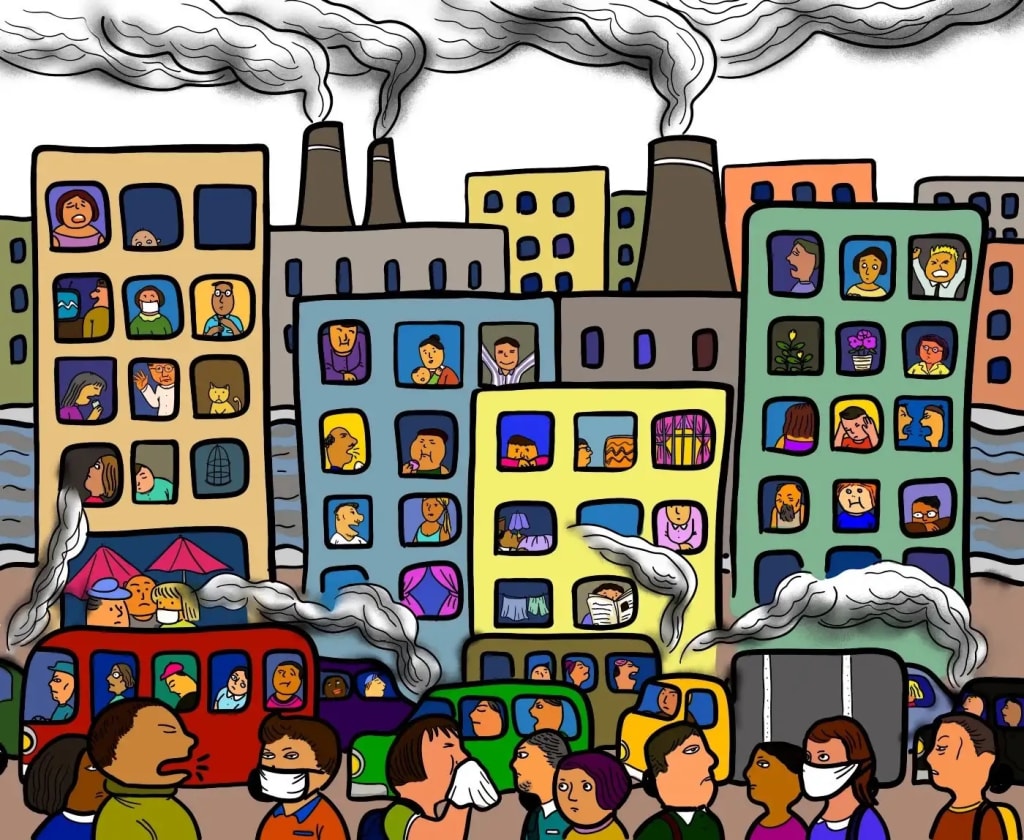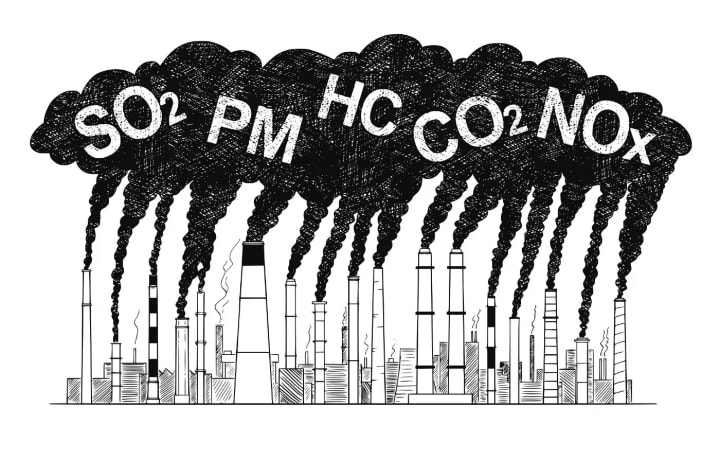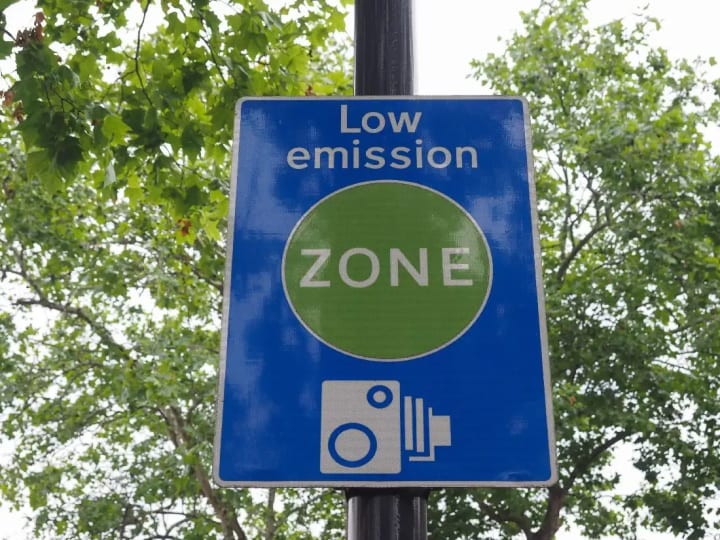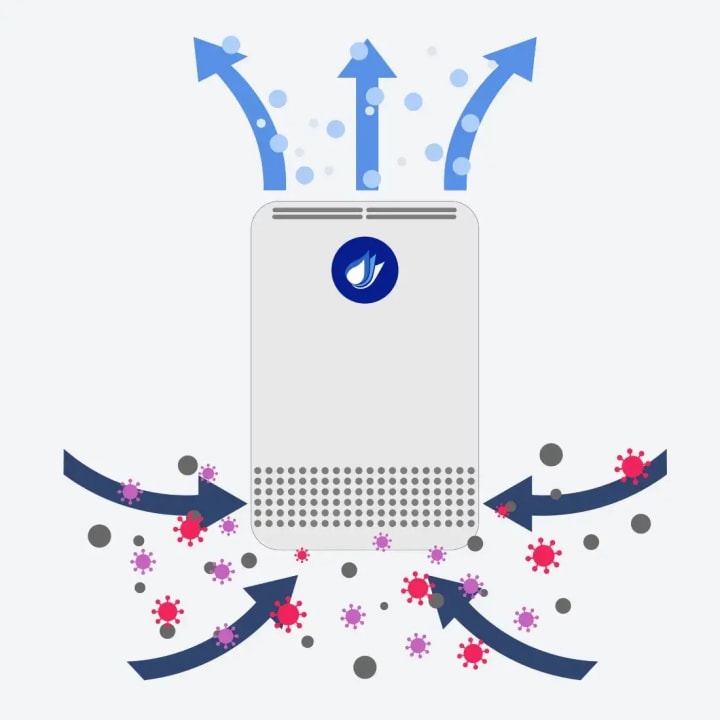The Effects of Air Pollution on Mental Health
It’s not just about saving the planet but also preserving the very quality of life

Our media is filled with many campaigns and news stories calling for governments and individuals worldwide to adopt more measures and new ways of living to protect the planet from years of continuous and reckless human destruction that date as far back as the beginning of time.
Conversations about increases in global warming, production of carbon emissions and other nasty air pollutants often center attention on the risks these problems pose to physical health, an undoubtedly important element of successful campaigning for climate change.
However, the damaging effect that air pollution can have on mental health and quality of life is often overlooked. One study at Kings College London revealed a positive correlation between increases in air pollution and greater uptake of mental health services in the London area, a link that if brought to the awareness of the public, could potentially encourage more environmentally friendly behaviours and lifestyles among people in communities.
In this story, we will examine exactly how air pollution impairs an individual’s mental health and the extent to which available interventions for tackling air pollution are effective in reducing the prevalence of mental health issues.
How Air Pollution Affects Mental Health

Theories relating to the causal link between air pollution and mental health problems mainly offer explanations that are derived from the fields of biology and neuroscience. According to scientific research, air pollution travels through the air pathways by entry of the nasal nervous system into the central nervous system and eventually reaching into regions of the brain with the potential to cause aversive changes in the brain’s structure.
Air pollution also has the ability to cause similar structural changes to the brain’s composition by entry into the vascular system followed by subsequent travel through the brain’s blood barrier.
Not only are these changes in brain structure linked to the development of mental health and mood disorders but can also lead to the contraction of other disorders associated with cognitive impairments such as Parkinson’s disease, Alzheimer’s disease, and many other well-known forms of dementia.
It is well-known that aging adults undergo a gradual decline in cognitive function but a series of studies in adults over the age of 50 years old reveal that these declines are more pronounced in aging adults exposed to the highest levels of air pollution, thus having a greater risk of contracting cognitive-related disorders than those exposed to lower levels of air pollution.
However, investigative literature into these links are not limited to human research. Similar adverse effects of air pollution on cognitive function have also been observed and documented in a series of studies involving rats. Randy Nelson, a Ph.D. neuroscientist at Ohio State University, exposed rats to a similar concentration of air pollution inhaled by humans on a weekly basis and found that mice who had been exposed to this level of air pollution performed significantly worse on maze tasks than mice who experienced no such exposure.
It is therefore evident that exposure to air pollution can have impairing effects on the mental and cognitive well-being of all living creatures, but the level of damaging effects on these phenomena is dependent on the type/s of air pollution one is exposed to.
Types of Air Pollution

Many different types of air pollutants exist, all of which can be detrimental to health and cause significant problems with bodily functioning. However, the extent to which these air pollutants cause such levels of harm is inequal in proportion as some air pollutants are known to be more harmful to wellbeing than others. Research focusing on the links between air pollution and mental health typically study the effects of nitrogen oxide, particulate matter and particle pollution on levels of mental health problems in communities.
The first one, nitrogen oxide, is a gaseous pollutant capable of reaching a maximum of 21.15 degrees Celsius in hot weather conditions, thus posing itself as a dangerous and corrosive gas during cold weather conditions too. Vehicular emissions and industrial waste are the largest creators of nitrogen oxide and are, thus, largely present in high densely populated urban areas.
The harmful effects of nitrogen oxide on mental health in urban communities has been well documented and understood in scientific literature with one study, in particular, demonstrating the mental health effects of nitrogen oxide exposure to outweigh the effects imposed on physical health in urban environments.
The other two pollutants, particulate matter and particle pollution, are tiny droplets usually generated from the same sources as nitrogen oxide with the inclusion of fires and wood burning materials as prominent creators in its formation.
However, these particles differ in size and consequently the extent to which they are detrimental to human health. By comparison, particulate matter is often smaller in shape relative to particle pollution and is therefore more easily able to penetrate through bodily defenses and cause greater deterioration to health and mental functioning.
According to Jennifer Weuve, assistant professor of internal medicine at Rush Medical College “conventional wisdom is that coarse particles aren’t as important as fine particles when it comes to human health”, thus serving as a possible explanation for the lack of available research literature into the effects of particle pollution on the prevalence of community-level mental health problems.
However, Weuve’s findings from a 2012 study suggest an equal role of both particles in contributing to declines in cognitive performance. She found that women aged 70–81 years old who had been exposed to high levels of both particulate matter and particle pollution experienced significantly greater cognitive deterioration than women within the same age bracket who had been exposed to lower concentrations of both pollutants.
Therefore, Weuve’s findings serve as strong evidence indicating that exposure to both particles can be asserted as a high-risk factor in the future development of disorders associated with cognitive decline such as dementia and Alzheimer’s diseases.
While all three pollutants differ in the level of threat posed to mental health and cognitive function, the damage each of these pollutants cause to both aspects of living, as evidenced in these studies, leaves plenty of cause for concern. The worry of these alarming research findings has been compounded further by the fact that 99% of the world’s population resides in areas that exceed the World Health Organization’s recommended guideline limit for levels of air pollution in a community.
It is also worth noting that global increases in mental health disorders, which are being accompanied by rising climate temperatures, highlight the need for immediate adoption of interventions to effectively manage and respond to the emerging climate crisis in a way that facilitates an improvement in both the physical and mental wellbeing of people worldwide, with a particular emphasis on supporting those groups most affected.
Interventions for Tackling the Mental Health Climate Crisis

In response to these issues, the World Health Organization has devised an action plan that seeks to address the climate crisis through the practice of policies that promote an enhanced quality of both physical and mental health.
Some key facts mentioned in the plan include a lack of mental health workers in large populations (13 per 100,000 people), mental health problems accounting for 15% of years lived with a disability, 1 billion people worldwide contracting a mental health disorder, the costs associated with mental health problems ($1,000,000,000,000) and only 2% of governments health budgets being spent on improving mental health.
Recommendations for intervention design include integration of climate change initiatives into policy-making decisions for mental health, the inclusion of mental health considerations in policies targeted towards tackling the climate crisis, building upon global commitments, implementation of community-based approaches to support communities most psychologically affected by the crisis and a devised strategy to deal with gaps that exist in funding for mental health support and provision.
This action plan also encourages governments and institutions to minimize the influence of other factors (e.g., socioeconomic status, race, ethnicity) in the development of physical and mental health problems to support those groups more disproportionately affected by the crisis such as those living in poverty, adults of an elderly age or those of black racial and/or ethnic minority status.
Types of Interventions and Their Impacts
Prior to assessing the impact of air pollution interventions on mental health and quality of life, it is useful to distinguish between the different types of interventions that exist for tackling air pollution. One study, which examined a range of commonly used and available interventions for tackling air pollution divides interventions into three categories.
The first set of characterized interventions, source-level interventions, focus on reducing air pollution through methods that attempt to tackle air pollution at its key sources. Congestion charging, road pricing, and highway tolls schemes are the most notable examples of interventions used to tackle air pollution in its core dimensions and have been demonstrated through research practice to contribute to improved mental well-being in largely populated urban environments.
London’s implementation of its Low Emissions Zone (LEZ) perfectly illustrates this success with one study showing these measures to have reduced diagnoses of anxiety related disorders by 6.5% and increase feelings of happiness, worthiness and life satisfaction by 1.3%, 1.3% and 1% respectively in the London city area. Figures of this scale may seem insignificant but have nevertheless highlighted a slight improvement in the mental well-being and quality of life for those residing in London’s city district, which is undoubtedly a better outcome than no improvement at all.

The second set of interventions, ‘macro-scale interventions’ focuses on tackling air pollution at a mass scale. These interventions prioritize the targeting of areas and environments in which mass quantities of air pollution are prevalent and thus require large-scale action from associated governments and local authorities to tackle its excess presence.
Some of the most common macro-scale interventions used are air ionization systems, absorbent billboards, solar-assisted cleaning systems, vehicle and roadside communications, and water sprinkling systems, all of which have demonstrated a high level of effectiveness in reducing air pollution.
However, the subsequent physical and mental health effects are only understood in literature reviews examining the use of the first of those interventions mentioned, air ionization systems.
Air Ionization systems are often used indoors and operate by transmitting negative air ions into indoor air space. Evidence of its effectiveness on mental well-being is not fully known as different studies have provided mixed results on this effect.
However, air ionization systems have been documented as an effective treatment option for patients with general mood disorders. An experimental study in Italy found that exposure to negative air ions functions as an effective treatment for these disorders on an equal level to what is commonly observed among patients on anti-depressant medication prescriptions.
Other evidence has also discovered air ionization systems to serve as a useful treatment plan for those experiencing chronic or seasonal depressive disorders. A meta-analysis of its implementation demonstrates high exposure to negative air ions as a successful combating agent for both these forms of depression.
However, low exposure to these same air ions was only observed as an effective treatment course for those diagnosed with a seasonal type of depression. It is also important to note that this same study found no evidence of an effective link in patients with anxiety or mood-related disorders.
Any lack of effect on these conditions could explain why another study found that while air ionization systems have the potential to improve cognitive functions, they demonstrate no such potential to improve an individual’s overall well-being.
However, there is no available research evidence that implies the existence of harmful effects imposed by air ionization systems on an individual’s physical and mental state. Though, uncertainties concerning their effectiveness require careful and thoughtful prior consideration by healthcare institutions in acknowledgment of the high costs associated with the implementation of these systems.

The final set of interventions, ‘Micro-Scale Interventions’ focus on tackling air pollution at the level of individual exposure. Interventions of this scale are utilized in a practical manner that offers individuals protection against exposure to well-known dangerous air pollutants, particularly those which are harmful to physical and mental health at extreme levels such as PM2.5.
The only recognized type of intervention identified within this domain is NasoFilter-sprays and rigorous scientific trials have noted the contribution of these filter sprays in providing significant levels of protection against exposure to even some of the highest concentrations of toxic air pollution typically recorded in urban settlements.
One study involving a group of Chinese soldiers, commonly exposed to high levels of air pollution, found that an application of the rIFNa-2b nasal spray was accountable for a number of significant reductions in the rates of infection for common respiratory diseases among the Chinese army camp, thus serving as concrete evidence for the effective role of nasal sprays in protecting against the inhalation of toxic air pollutants.
In subsequent terms, the protective benefits associated with NasoFilter-sprays have been documented as an effective liquid application that fosters an indirect improvement in a person’s physical and mental health.
One study among a group of patients identified as mentally ill under the criteria set by the Diagnostic and Statistical Manual for Mental Disorders (DSM 5) found a decrease in symptoms for major depressive disorders after receiving a treatment course in the form of a newly developed nasal spray, Esketamine.
Moreover, these findings demonstrated a pattern of consistency among patients diagnosed with all forms of mental disorders, including those who have been known to express previous ideations and tendencies relating to suicide. However, the benefits offered by Naso-Filter-sprays extend beyond improvements to wellbeing.
These filter-sprays have also been shown to serve as an additional protective layer against the inhalation of coronavirus or other disease related particles. Domestic Research into the effects of the new Isreali Taffix Nasal Spray found that the spray was responsible for a 78% reduction in infection rates among a large Jewish congregation who were offered the spray compared to a control group among the congregation that didn’t receive the spray.
This protection occurs due to a blockage formed by the spray’s liquid within the nasal cavity area (i.e. the nose), thus providing strong protection against all types of disease infection.
This particular benefit of NasoFilter-sprays led to an inevitable generation of high pharmaceutical demand for these products during the most restrictive phases of the coronavirus pandemic. While there are no publicly available records for the number of sales and profits accumulated for Taffix Nasal Spray in recent years to support this assertion, its high demonstration of efficacy against the coronavirus disease was sufficient in attracting fast-tracked medical approvals in both Israel and several parts of Europe which highlight the product’s urgent demand during covid-19 lockdowns.
In theory, Naso-Filter Sprays contain an element of versatility that enables nasal protection against any type of air contaminants that can be extremely detrimental to health and wellbeing and are thus a viable commodity amidst any public health crisis.

Evaluation of Intervention Types
In reviewing the effectiveness of these intervention types, it is evident that some types of interventions are more effective than others. However, just as governments rely on the implementation of more than one type of public health intervention to combat the spread of a disease during a global pandemic, so too does the fight against air pollution require a comprehensive utilization of all three intervention types to disrupt the prevailing transmission of all toxic air pollutants and subsequently protect the health and wellbeing of the public in addition to preserving the future of planet earth.
This is largely due to the fact that different intervention types offer unique sets of functions that make them only effective for specific purposes. For example, in a disease pandemic, the adoption of a vaccination programme to protect the public against the contraction of the disease would be an insufficient measure on its own because vaccination does not offer full protection against disease infection and is unable to treat those who have already contracted the illness.
Therefore, vaccination efforts should be supplemented through a wide coverage of cheap and easily accessible treatments to treat members of the public who have already been infected with the disease.
Equally, the provision of a widely available and accessible treatment programme would also be an insufficient measure on its own because while treatments are effective in healing infection, they are incapable of offering protection against future contractions of the disease.
The very same principles are true for utilizing interventions responsible for tackling air pollution. The first set of interventions, source-level interventions, is a useful collection of strategies that can be adopted to tackle air pollution at its core elements. However, these intervention types are ineffective measures for tackling already existing mass quantities of air pollution or offering individual protection against exposure.
The second set of interventions, macro-scale interventions, are an important set of interventions that can tackle air pollution at its level of mass pollution, but these interventions do not serve the function of tackling air pollution at its source or providing protection at the level of individual exposure.
The latter benefit is one that is offered by micro-scale interventions and the application of Naso-Filter sprays, but these liquid applications are not able to offer the benefits associated with the other two intervention types, tackling air pollution at source and mass levels respectively.
However, if all three intervention types are adopted, then air pollution can be tackled in all of its dimensions, thus easing the challenge of combating its presence and the problems they develop, including mental health issues.
Final Thoughts
It is clear from all the evidence presented in this story that air pollution not only functions as a destructive force in the sustainability of our planet and the preservation of human life but also has the potential to cause similar levels of destruction to human mental health and quality of life.
Therefore, climate change is not just about saving the planet and promoting better physical health but also about promoting better mental health and enabling human beings to experience a quality of life that brings happiness and fulfillment into their everyday lives.
Fortunately, the list of available interventions to tackle air pollution and enact indirect positive changes to mental health is vast in supply and if interventions are utilized from all three intervention types, then the unique benefits provided by all three intervention types can be experienced through subsequent improvements in both physical and mental wellbeing. However, swift action is required on the part of governments, institutions, corporations, and individuals at large to promote these changes.
If interventions are implemented quickly in the immediacy of this neglected truth, then humanity can attain a sense of optimism that not only provides hope for a prolonged future for planet earth and its inhabitants but also a happier and more joyful life for as many living on this planet as possible.

About the Creator
Andrew-Stuart
My passion is to write stories related to the topics of psychology and mental health | (Bsc) Hons Applied Psychology Student at Glasgow Caledonian University 😁
Enjoyed the story? Support the Creator.
Subscribe for free to receive all their stories in your feed. You could also pledge your support or give them a one-off tip, letting them know you appreciate their work.






Comments
There are no comments for this story
Be the first to respond and start the conversation.